Education and Outreach
PARC Scientists Get Involved in Numerous Events in the Community Each Year, Including:
K-12 Education & Outreach
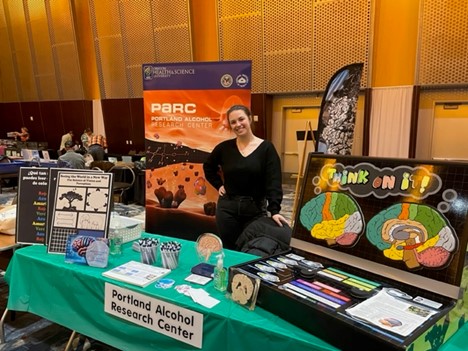
Our K-12 education aim is grounded in evidence-based early intervention strategies that have been well documented as effective in disseminating information from health, education, social and behavioral science fields. The early intervention strategies proposed by this Core promote keeping one’s brain safe, making informed choices, and making children’s study of science normative. Within our early intervention program, we employ well-founded and widely used cognitive and behavioral techniques of: 1) role-modeling by female and male neuroscientists, teachers, and peers, 2) hands-on demonstration of what goes on in the field of neuroscience, and alcohol research, and 3) multiple-reinforcement of this aim’s messages and experiential opportunities.
Return to top
OHSU coordinated events
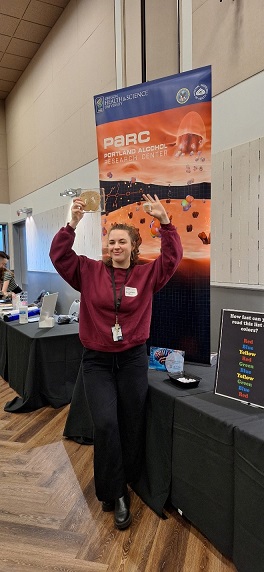
During the current funding cycle OHSU created the Office of Science Education Opportunities. The office is staffed by eight people including four community liaisons, and a middle-school coordinator. This office organizes 4-6 outreach opportunities for middle and high school students from underserved communities, including multiple OnTrack OHSU! visits. Also OHSU has been recognized by the Society for Neuroscience as having one of the largest series of Brain Awareness events in the nation. These events include a public lecture series (5000 attendees), a K-12 teachers’ workshop (150-300 participants), and a Brain Fair (1000-1500 attendees/day) in collaboration with the local Oregon Museum of Science & Industry. PARC has been a seminal partner with OHSU in these events since their inception in Spring 2000. Each year for Brain Awareness Season, PARC investigators and NIAAA T32, F30, F31, and F32 trainees engage the public and translate their science into interactive exhibits, programs, and informative talks. The trainees play a critical role not only in carrying out Brain Awareness activities, but also in passing the mantle of leadership and organizational knowledge from one graduate/postdoctoral cohort to another. PARC Brain Fair exhibits include:
1. Alcohol impairment simulation – Brain Fair attendees consistently rate this as one of the most popular of the Fair’s 40 interactive exhibits.
2. NIH timeline of discovery (created by Dr. Rutledge-Gorman, previous core lead) - the timeline highlights NIH health promotion, and breakthroughs by the Marine Hospital Service in 1880s to the present day.
3. Alcohol effects in men and women – highlighting differences in alcohol metabolism and the effects experienced after consuming specific amounts of alcohol.
Collaborations with outside organizations
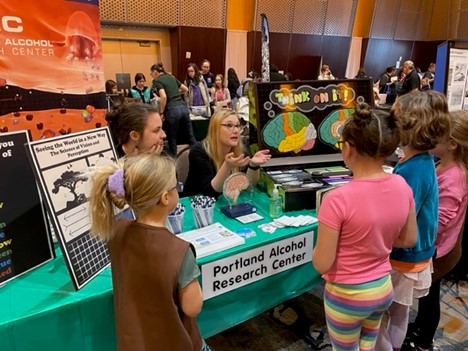
Girl Scouts of Oregon and Southwest Washington. In 2023, the PARC was invited to participate in STEM Day and participated again in 2024. This STEM expo is an all-day event with over 75 hands-on booths that let girls in grades K-12 participate in hands-on activities including code a robot in the robotics lab, discover farming technology at the greenhouse, or working on a car in the auto shop. The Girl Scouts restrict our discussion of alcohol and drugs, but the girl scout participants have been fascinated by our activities related to neuroscience and behavior. Being able to touch preserved brain slices, try out different visual illusions then learn how they work, and compete with their friends on who can name colors fastest in the Stroop-inhibition-of-habits task have been extremely popular.
Training in Alcohol Research (HS, UG, Grad, UME)

Since its inception, scientists affiliated with PARC have been instrumental in training the next generation of alcohol researchers. While the primary focus has been on research training for pre- and post-doctoral fellows, significant efforts have also been made to enhance the research pipeline by offering training opportunities to high school and undergraduate students. Below are examples of students involved in OHSU Research Programs in 2024.
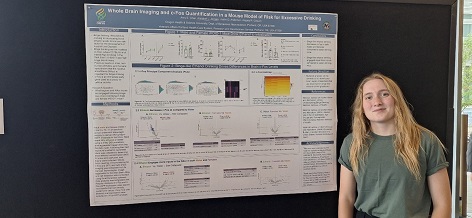
Annabel Jensen, Portland State University
Mentor: Angela Ozburn, Ph.D.
Annabel, a rising junior is interested in the neuroscience associated with substance use. She initially reached out to Dr. Ozburn to volunteer in her lab. Dr. Ozburn told her about OHSU's intern program, offering a structured and paid summer research opportunity. Annabel has had an opportunity to analyze the whole brain cFos data from alcohol exposed mice as her main project but has also had the opportunity to watch the collection of behavioral measures, as well as surgeries and tissue preparation procedures. These experiences, in addition to attending lab meetings and presenting to lab members, have given Annabel a feeling for what life is like as a graduate student conducting neuroscience research and increased her enthusiasm for a career in science. This feeling has been reinforced by the welcome that Dr. Ozburn and members of the lab gave to her and everyone’s willingness to provide mentorship as she learned the research techniques and processes.
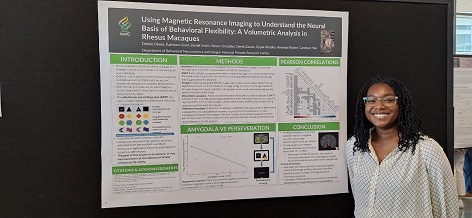
Debbie Okeke, University of Oregon
Mentors: Kathy Grant Ph.D. and Suzi Fei, Ph.D.
Debbie is interested in attending medical school but her experiences at the Oregon National Primate research Center (ONPRC) have made her consider applying to MD/PhD programs. Debbie has been working with Dr. Grant using magnetic resonance imaging (MRI) in rhesus monkeys to determine whether the brains of monkeys that show more flexibility in responding to environmental change differ from those that show less flexibility. This project has enabled Debbie to take advantage of the unique learning opportunities provided by the ONPRC and the researchers who are at the cutting edge of understanding the brain-behavior links in nonhuman primates, and the connection of these links to alcohol and substance use. Debbie commented that one thing that surprised her was the number of people who were critical to the research team from the veterinary staff caring for the animals, to the staff building and maintaining equipment, to the researchers analyzing and interpreting the data. She had thought that researchers were figures like Dr. Grant, her faculty colleagues and students, but realized that there is a network of collaborating individuals needed to make the research possible.
"Tell Your Story! A Media and Communications Guide for Scientists"
In order to encourage and enable greater dissemination of research findings in the wider community, the PARC in collaboration with OHSU's Methamphetamine Abuse Research Center (MARC) has produced a free media guide that offers practical strategies and tools to help scientists share their work effectively with the media and in presentations to the general public. The guide is freely available for download here.